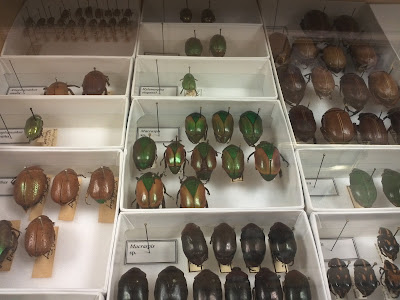Why?
My mentor had an upcoming funding presentation and when it comes to research science, you need to have some great PR once in a while to keep the public informed and supportive, and your funding steady. We have been working on iridescent fish scales and butterflies (the standard specimen when it comes to structural light coloration studies), but we hadn't yet looked at other land organisms. However, if we found some intriguing insects or what have you that were found in the San Diego area, it would be a good continuation of our structural coloration research and possibly serve as a contrast between marine and terrestrial iridescence.
When we arrived at the Natural History museum and taken behind-the-scenes to the entomological section, we had no idea what we were looking for. Granted, we knew what the glimmer and shine of iridescence looked like, but we were to look through hundreds, if not thousands of insects. At least the entomologists had an idea for where we should start.
The room was full of those large rolling shelving units like they have in the archives of big libraries. The metal cabinets lined the walls and only opened for one small passageway at a time before they closed their dull teeth behind you with the slow creaking sound of the old wheels. These were definitely archives--stored away behind dull gray doors that often stubbornly refused to open, unwilling to reveal the amazing specimens that were trapped in this fluorescent-lit prison, a zoo and a cemetery alike.
Inside the gray doors were wooden cases with glass on top to display the specimens, every one of which was pinned to the foam beneath. Many of them had labels that revealed (in what has to be some of the smallest legible writing in the world) the date of collection, genus/species, location of collection, and other notes. All of this information was crammed perfectly onto small tags pinned underneath the bugs.
The curator suggested we look at insects of the order Coleoptera, commonly known as beetles. They make up a lot of the collection at the Natural History Museum besides butterflies and Coleoptera actually has more organisms than any other order. So in a way, it was good to start there because there was so much to choose from, but that also meant that between the 3 of us, there were thousands and tens of thousands of beetles waiting to be seen. In the picture above there are about 45 cabinets. In each cabinet, there were anywhere from 6 to 12 display cases full of tens of beetles. And we looked through all the cabinets shown in that picture and more!
Some beetles looked plain and unassuming, but had great color contrast, which is important in the natural world. Mostly, we were looking for some beautiful examples of iridescence that was preferably not green iridescence, which is really common. We wanted more reds or purples, which are harder colors to produce and much rarer in nature.
 |
| Some very cool beetles. There's a very iridescent purple-blue-teal-green beetle in the middle and a scarab that looks like it truly was preserved in gold. |
 |
| From Arizona, these green beetles had amazing silver stripes down their backs. The light refracting off of them is the iridescence of the silver lines. |
 |
| Striking reddish purple coloring with green trimming defines these beetles. |
 |
| The common green iridescence with red highlights and ...posteriors. |
Although looking through all those beetles took us the better part of a day, ever the gluttons for punishment in the name of science, it was decided that we would probably go back in the near future to look for good damselfly or dragonfly specimens. Our only concern was being a burden to the ever helpful curator, who had the daunting task of rearranging the collection according to the ever-changing taxonomy standards that seem to be constantly re-classifying insects. It's no small task to reorganize a small entomological collection (only 900,000 bugs, remember?) The best of luck to him and to us as we delve deeper into the world of terrestrial organisms, which us marine biologists know surprisingly little about...










No comments:
Post a Comment